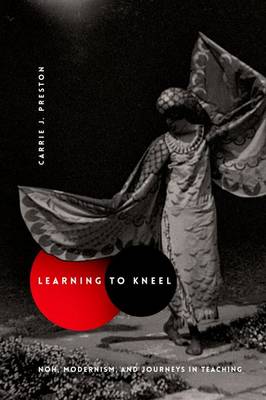11%OFF

Stock image for illustration purposes only - book cover, edition or condition may vary.
Learning to Kneel: Noh, Modernism, and Journeys in Teaching
Carrie J. Preston
€ 41.99
€ 37.45
FREE Delivery in Ireland
Description for Learning to Kneel: Noh, Modernism, and Journeys in Teaching
Hardback. Series: Modernist Latitudes. Num Pages: 352 pages. BIC Classification: 2GJ; AN; DSB; DSG. Category: (P) Professional & Vocational. Dimension: 238 x 163 x 32. Weight in Grams: 676.
In this inventive mix of criticism, scholarship, and personal reflection, Carrie J. Preston explores the nature of cross-cultural teaching, learning, and performance. Throughout the twentieth century, Japanese noh was a major creative catalyst for American and European writers, dancers, and composers. The noh theater's stylized choreography, poetic chant, spectacular costumes and masks, and engagement with history inspired Western artists as they reimagined new approaches to tradition and form. In Learning to Kneel, Preston locates noh's important influence on such canonical figures as Pound, Yeats, Brecht, Britten, and Beckett. These writers learned about noh from an international cast of collaborators, and Preston traces the ways in which Japanese and Western artists influenced one another. Preston's critical work was profoundly shaped by her own training in noh performance technique under a professional actor in Tokyo, who taught her to kneel, bow, chant, and submit to the teachings of a conservative tradition. This encounter challenged Preston's assumptions about effective teaching, particularly her inclinations to emphasize Western ideas of innovation and subversion and to overlook the complex ranges of agency experienced by teachers and students. It also inspired new perspectives regarding the generative relationship between Western writers and Japanese performers. Pound, Yeats, Brecht, and others are often criticized for their orientalist tendencies and misappropriation of noh, but Preston's analysis and her journey reflect a more nuanced understanding of cultural exchange.
Product Details
Publisher
Columbia University Press
Format
Hardback
Publication date
2016
Series
Modernist Latitudes
Condition
New
Number of Pages
352
Place of Publication
New York, United States
ISBN
9780231166508
SKU
V9780231166508
Shipping Time
Usually ships in 4 to 8 working days
Ref
99-1
About Carrie J. Preston
Carrie J. Preston is associate professor of English and director of the Women's, Gender, and Sexuality Studies Program at Boston University. Her book, Modernism's Mythic Pose: Gender, Genre, Solo Performance, won the De La Torre Bueno Prize, and her articles have appeared in Modernism/modernity, Theatre Journal, Twentieth-Century Literature, and Modernist Cultures.
Reviews for Learning to Kneel: Noh, Modernism, and Journeys in Teaching
What drew Western writers to an arcane, highly stylized form of Japanese court theater? As a scholar, Carrie J. Preston answers this question by way of the archive, unearthing a global network of dancers and writers. But she also pursues this question as a student, subjecting herself to the rigors of noh training. The result is an unusual blend of both approaches, a magisterial study in cultural history that is also a compelling story of teaching and learning.
Martin Puchner, Harvard University Eloquently, movingly, and persuasively, Preston traces modernism's fascination with noh through European and Japanese histories of poetry, drama, and performance. She asks us to reflect on the project of cross-cultural learning, what it means to know another culture as well as what it means to know one's own. A tour de force of memoir and scholarship, at once entertaining and erudite, Learning to Kneel shows us why mistranslation, partial fluency, and failing to understand have been crucial to the transnational history of modernism.
Rebecca Walkowitz, Rutgers University Kneel before this humbling account of submission and, at times, personal but never sentimental antidote to both easy celebrations of multiculturalism and easy critiques of cultural appropriation. Sitting with calm strength at the intersections of performance, pedagogy, and the politics of 'global modernism,' Preston successfully reinvents the modernist reinvention of noh as a timely, urgent topic by asking what it means to succeed or fail. Don't fail to read it.
Christopher Bush, Northwestern University In Learning to Kneel, Preston tells the story not only of the influence of Japanese culture and noh theater on modernist writers from Yeats to Beckett but also of her personal experience as a neophyte practitioner of noh. Together, these narratives brilliantly reframe received ideas about cross-cultural aesthetic transformation, the relation of success and failure in art, and the tension between subversion and tradition that underlies any form of training or pedagogy.
Scott Klein, Wake Forest University
Martin Puchner, Harvard University Eloquently, movingly, and persuasively, Preston traces modernism's fascination with noh through European and Japanese histories of poetry, drama, and performance. She asks us to reflect on the project of cross-cultural learning, what it means to know another culture as well as what it means to know one's own. A tour de force of memoir and scholarship, at once entertaining and erudite, Learning to Kneel shows us why mistranslation, partial fluency, and failing to understand have been crucial to the transnational history of modernism.
Rebecca Walkowitz, Rutgers University Kneel before this humbling account of submission and, at times, personal but never sentimental antidote to both easy celebrations of multiculturalism and easy critiques of cultural appropriation. Sitting with calm strength at the intersections of performance, pedagogy, and the politics of 'global modernism,' Preston successfully reinvents the modernist reinvention of noh as a timely, urgent topic by asking what it means to succeed or fail. Don't fail to read it.
Christopher Bush, Northwestern University In Learning to Kneel, Preston tells the story not only of the influence of Japanese culture and noh theater on modernist writers from Yeats to Beckett but also of her personal experience as a neophyte practitioner of noh. Together, these narratives brilliantly reframe received ideas about cross-cultural aesthetic transformation, the relation of success and failure in art, and the tension between subversion and tradition that underlies any form of training or pedagogy.
Scott Klein, Wake Forest University
